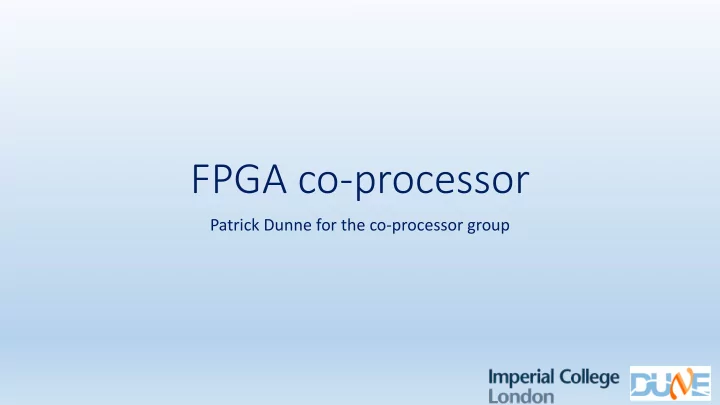

FPGA co-processor Patrick Dunne for the co-processor group
Introduction • Co-processor will take care of data compression and trigger primitive generation • Co-processor will also perform data buffering for supernova trigger • Sits on FELIX cards and processes data from warm interface boards (WIBs) before it is passed to PCs Supernova Buffer Co-processor WIB WIB FELIX WIB Cryostat PCs PCIe board inside a PC WIB WIB Patrick Dunne 2
Requirements and specifications • On receipt of supernova trigger must be able to record 100s of full waveform data including O(10s) before the trigger signal • Must buffer data until non-supernova trigger decision can be made and read out selected events to back-end • Should compress data losslessly by at least a factor of 2 • Must form trigger primitives (filtered waveforms, hits etc.) • Need a software framework that can control, configure and monitor the health of the board and detector via trigger statistics Patrick Dunne 3
Interfaces, constraints • Input via FELIX card covers one APA using 10x10 Gb/s optical links from WIBs • Contains data from 2560 channels sampled at 2MHz 12 bit • Board will contain 64 GB of DDR4 RAM for the O(10s) buffer • Board will contain 2 NVMe SSDs for 100s buffer • Each drive has a 4x Gen3 PCIe interface • Firmware and software currently being developed using a dev board • Final production will be a daughter card mounted on FELIX Patrick Dunne 4
Key challenges • Demonstrating correct/adequate performance with a realistic LArTPC • Optimise split of functionality between FPGA and CPU given stringent power constraints • Produce hardware with sufficient reliability to meet system requirements and verify this (i.e. design adequate QA processes) • Most of these challenges can be met through extensive testing of the system at ProtoDUNE Patrick Dunne 5
System design • Board will have parallel instances of TPG (15 instances) and Compression blocks (40 instances) each processing 64 channels Data Optical selection/ FELIX Data routing and PC interface WIB input links storage Combiner/ Buffer Compression splitter controller SSD ‘’100s” buffer Trigger Primitive Generator DDR4 ‘’10s” buffer Hit Filter Pedestal Finder Patrick Dunne 6
Filter/pedestal subtraction • Filter is 32 tap FIR filter • Firmware written and simulated • Pedestal subtraction in development • Resource use estimates indicate should fit in reasonable FPGA: • 32-tap FIR (x15): 5.52% LUTs, 2.12% FFs, 8.69% DSPs (percentages of KU115 resources) Patrick Dunne 7
Hit finding • Starts from filtered, pedestal subtracted samples • Record peak height, length of hit, start of hit, integrated ADC • Firmware synthesised and simulated • Resource estimate suggests no problems • IO estimate below assumes 32 bit input (12 bit in final design) Patrick Dunne 8
Compression • Fibonacci encoding via LUT implemented in firmware and simulated • Encode delta from previous sample so most entries are zero • Compression factor depends on noise profile of samples • Resource estimate suggests ~1% of Block RAMs used per compression stream • 40 instances should fit on the FPGA without issues Patrick Dunne 9
Validations so far • Daughter board layout produced based on design initially made for previous version carrier board • Design revisions underway for prototype manufacture • Firmware: • Compression block (Imperial), hit finder (Bristol), filtering and pedestal subtraction (RAL) are written and simulated, integration ongoing • Buffer controller (UCL) is being developed and simulated • Initial resource estimates indicate it will fit in a cost-effective FPGA Patrick Dunne 10
Hardware: Development up to the EDR and production • Early 2019: • Prototype based on current DPM design using FMC+ daughter-card format • Detailed specification of FELIX-daughter card mechanical interface • Later 2019: • Second prototype based on lessons learned from first, final mechanical spec (FELIX) and production optimisations • Build testing platform • Medium-sized production O(20) boards • 2020: • Third prototype with robustness and testability improvements, manufacturer final optimisations • 2021: • Pre-production and QC implementation • 2022-2023: • Staged production over 18 month timescale is achievable given past experience Patrick Dunne 11
Development plan up to the EDR – Integration/Firmware/Software • Early 2019: • Firmware framework and algorithms slice tested on a development card • Ensure algorithms that fit FPGA meet physics requirements • Later 2019: • Firmware interface for data IO to FELIX card designed, test platform to generate fake data built • Firmware ported to DUNE hardware daughter card • Prototype control software ready that allows O(20) boards to be used together • 2020: • Production ready firmware, software and test platforms • Software work will focus on automation and integration with general DUNE backend electronics control framework • Planning several slice tests as hardware/firmware is ready 1) All co-processor firmware on a development board 2) Development board interfaced with FELIX and dummy WIB interface 3) Co-processor daughter card hardware on FELIX with dummy WIB interface 4) FELIX plus co-processor card interfaced to real WIB at ProtoDUNE Patrick Dunne 12
Summary • We have a well understood specification • The first iteration of hardware development is taking place now based on an existing layout • The key question is do hardware constraints allow physics requirements to be met and we have a plan to answer this using ProtoDUNE • 2019: Test of concept using full slice of system • 2020: Testing of full system to check reliability is sufficient Patrick Dunne 13
Recommend
More recommend